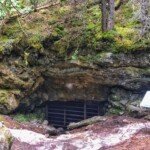Discovered in 1904, the 5.9 km passages of the Nakimu Caves in Glacier National Park have been re-opened to the public. They feature spectacular carbonate ‘moonmilk’ deposits, with numerous passageways and grottos. Guiding services are available. The caves are reached by hiking three to four hours up and over a mountain pass.
Visitors’ efforts will be rewarded by the unique experience of descending, by the light of headlamps, into the dark labyrinth of the caves. Numerous passageways and grottos, totalling 5.9km in length, contain intriguing natural features such as soda straws, rock fluting and moon milk. Short steep scrambles and uncertain footing are characteristic of the cave experience.
Park visitors can access the caves by either joining a commercially led trip, or applying for their own entry date through a lottery system. One Nakimu Cave Pass will be issued for every Saturday or Sunday from approximately mid-July to mid-October. Parties must consist of between six and twelve people, and be led by experienced cavers.
For an experience under this world, visitors shouldn’t pass up the opportunity to visit Cody Caves Provincial Park in the Selkirk Mountains, eight steep but well-marked miles (13 km – sometimes rough in places) off Hwy 31 on the west side of Kootenay Lake about 2 miles(3 km) north of Ainsworth Hot Springs. Open mid-June to mid-September depending on the condition of the road, this unique park is dedicated to preserving a cave system and an underground stream flowing through ancient limestone formations. The access road is unsuitable for low-clearance vehicles, motorhomes or vehicles with trailers. Guiding and transportation companies in nearby Kaslo can accommodate the transportationally challenged.
Due to the extremely delicate nature of the cave formations, and to protect the inexperienced caver, the underground experience is available by guided tour only. Cave tours usually depart on the hour with the first tour at 10 am, and the last tour at 4pm daily from July 1 to the end of August. Helmets, headlamps and gloves are provided at the cave mouth. Visitors must come equipped with sturdy outdoor footwear and warm clothing.
The caves in the Cody Caves System are fascinating. About 875 yards (800 m) of passageways are explorable, revealing impressive displays of various types of calcite formations, such as stalagmites, stalactites, moonmilk, soda straws and waterfalls, bacon strips, rimstone dams, galleries and chambers. A regular one hour tour requires no reservation, and special 3-hour adventure tours can be arranged for groups of four to six persons. For more information contact the Park District office below, or the Visitor Centre in Nelson.
The Cody Caves were discovered in the early 1890s by Henry Cody, while out prospecting for silver. The caves were the subject of a short story written by Roger Pocock in 1899, titled The Noble Five, which described a cave whose inner chambers were walled with gold ore. The caves grew in popularity and were visited by many locals and curious individuals including, in 1908, the governor General of Canada, Earl Grey.
Though not walled with gold, the caves do contain an impressive display of calcite formations that are extremely old and have been growing at an average rate of about one cubic centimetre a century. The cave itself began formation when limestone beds laid down almost 600 million years ago were thrust upward by mountain building forces that occurred around 170 million years ago.
Cody Caves Provincial Park also has an outside display, a day-use area, and some hiking trails.


